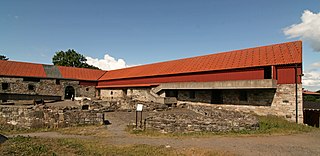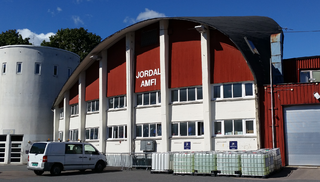
Hamarhus at Hamar in Hedmark was the fortified palace of the bishop of the Norwegian Catholic Diocese of Hamar. The castle was east for Hamar Cathedral, and was linked to the cathedral. The castle was constructed in stages, the oldest parts of stonework was erected around 1250 or a little later, and consists of three vault cellars white wooden roofing, and a large castle tower with ground floor approx, 10 x 18 m, with basement.
Results from Norwegian football (soccer) in the year 1913.
Results from football in Norway in the year 1914.
Results from Norwegian association football in the year 1917.
Results from Norwegian football in 1937.

Helge Thiis was a Norwegian architect. He is most noted for service as head architect at the restoration of Nidaros Cathedral.

Jordal Amfi was an indoor ice hockey rink in Oslo, Norway, the first bearing that name. The venue opened in 1951 to host the 1952 Winter Olympics. Jordal was also the site of the 1958 and the 1999 IIHF World Championship. It would in the following decades also serve several boxing matches and concerts.
Johan Vilhelm Aubert was an influential Norwegian sociologist. He was a professor at the Faculty of Law, University of Oslo from 1963 to 1971 and at the Department of Sociology from 1971 to 1988. He co-founded the Norwegian Institute for Social Research already in 1950, and has been labelled the "father of Norwegian sociology". In his early life he was a member of the anti-Nazi resistance group XU, and while later involved on the radical wing of the Labour Party, he edited the newspaper Orientering.
The 1913 Norwegian Football Cup was the 12th season of the Norwegian annual knockout football tournament. The tournament was open for 1913 local association leagues (kretsserier) champions, and the defending champion. Odd won their fifth title, having beaten the defending champions Mercantile in the final.
The 1914 Norwegian Football Cup was the 13th season of the Norwegian annual knockout football tournament. The tournament was open for 1914 local association leagues (kretsserier) champions. Frigg won their first title, having beaten Lyn (Gjøvik) in the final.
The 1915 Norwegian Football Cup was the 14th season of the Norwegian annual knockout football tournament. The tournament was open for 1915 local association leagues (kretsserier) champions. Odd won their sixth title, having beaten Kvik (Fredrikshald) in the final.
The 1917 Norwegian Football Cup was the 16th season of the Norwegian annual knockout football tournament. For the first time, the tournament was open for all members of NFF. Sarpsborg won their first title, having beaten Brann in the final. This was the first final that was played on grass.
The 1927 Norwegian Football Cup was the 26th season of the Norwegian annual knockout football tournament. The tournament was open for all members of NFF, except those from Northern Norway. Last years losing finalist Ørn won 4–0 against Drafn in the final, and won their second title. Odd were the defending champions, but were eliminated by Drafn in the quarterfinal. The final was the first and only final that was played in Sandefjord.
The 1929 Norwegian Football Cup was the 28th season of the Norwegian annual knockout football tournament. The tournament was open for all members of NFF, except those from Northern Norway. The final was played at Stavanger Stadion in Stavanger on 20 October 1929, and was contested by the defending champions Ørn and Sarpsborg, who had last won the tournament in 1917. Sarpsborg won the final 2-1 after extra time, and secured their second Norwegian Cup championship.
The 1935 Norwegian Football Cup was the 34th season of the Norwegian annual knockout football tournament. The tournament was open for all members of NFF, except those from Northern Norway. The final was played at Sarpsborg Stadion in Sarpsborg on 20 October 1935, and Fredrikstad secured their second title with a 4–0 win against local rivals Sarpsborg, who lost their second consecutive cup final.
The 1936 Norwegian Football Cup was the 35th season of the Norwegian annual knockout football tournament. The tournament was open for all members of NFF, except those from Northern Norway. The final was played at Ullevaal Stadion in Oslo on 25 October 1936, and was contested by the defending champions Fredrikstad and the two-time former winners Mjøndalen. Fredrikstad successfully defended their title with a 2–0 victory, securing their third Norwegian Cup trophy.
The 1937 Norwegian Football Cup was the 36th season of the Norwegian annual knockout football tournament. The tournament was open for all members of NFF, except those from Northern Norway. The final was played at Urædd Stadion in Porsgrunn on 17 October 1937, and was contested by the previous year's losing finalist Mjøndalen and the eleven–time former winners Odd. Mjøndalen secured their third title with a 4–2 win in the final. Fredrikstad were the defending champions, but were eliminated by Mjøndalen in the semifinal.

Ekebergrestauranten is a restaurant and banquet facility in a hillside overlooking downtown Oslo, Norway. Ekebergparken Sculpture Park is the nearest neighbor. The restaurant has been owned by Christian Ringnes since 2005.
Carl Julius Bergstrøm was a Norwegian architect who worked in the city of Trondheim from 1872 until his death in 1898.





